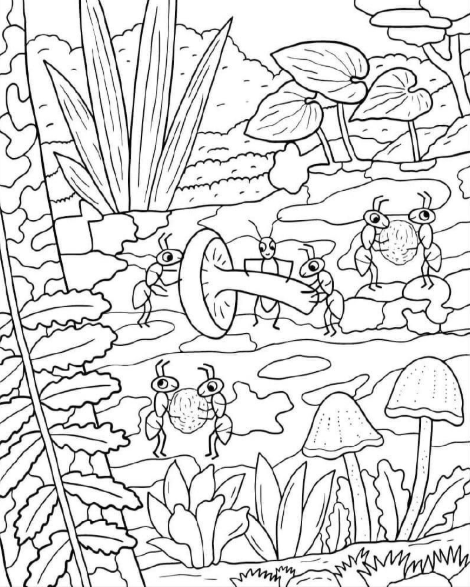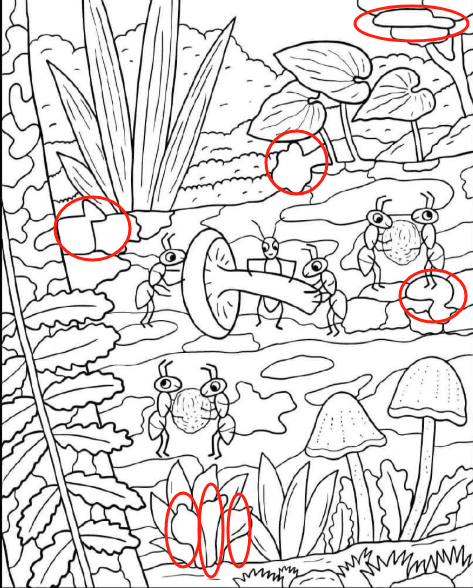Exploring the Enchanted Forest Floor: Discovering Hidden Ant Trails and Mushroom Mysteries
The Allure of Nature’s Microworld
Have you ever knelt down at the base of a tree and noticed a tiny universe bustling just inches beneath your gaze? This intricate black-and-white illustration captures a moment of wonder on the forest floor—mushrooms sprouting among ferns and foliage, while a troop of industrious ants scurries about. It’s an invitation to slow down, peer closely, and uncover the hidden life that thrives where most of us walk right by. Whether you’re a nature buff, an art enthusiast, or simply someone seeking a mindful moment, this scene offers layers of discovery. Let’s journey into its details and learn how to unlock its secrets.

Anatomy of the Forest Floor Scene
Before diving into the ants’ activities, let’s orient ourselves:
- Canopy Edge:At the top, leafy plants and tall grasses hint at the dense woods beyond.
- Midground Action:A fallen log or rock shelf provides a highway for our ant protagonists.
- Focal Point Mushroom:A single, uprooted mushroom lies horizontally, its cap poised like a rounded umbrella.
- Background Growth:Large leafed plants and scattered puddles set the damp, fertile tone.
- Foreground Flora:Mossy groundcover and clusters of smaller mushrooms frame the bottom edge.
Understanding the layout helps you spot every ant, every toadstool, and every nuance that makes this drawing come alive.
Meet the Micro-Engineers: Ants at Work
Ants are among nature’s most fascinating engineers. In this scene, you can observe:
- Carrying and Teamwork:Notice how three ants shoulder one side of the horizontal mushroom’s stem, while two more grip the opposite end. This tug-and-carry choreography mirrors real-life ant cooperative behavior when transporting oversized food.
- Scouting and Communication:An ant perched on the log’s ledge appears to stand sentinel—its antennae raised, ready to signal danger to the others. This alert posture reflects their real-world role as scouts.
- Nest Maintenance:Near the bottom left, an ant digs among the ferns, likely tidying up the nest entrance or excavating soil—a subtle but critical task for colony hygiene.
By capturing these distinct roles, the artist pays homage to the ants’ complex social structure.

The Magic of Mushrooms: Fungal Architects of the Forest
Mushrooms aren’t just scenic props; they’re key players in forest ecology:
- Nutrient Recycling:Fungi break down dead organic matter—leaves, wood, and fallen branches—releasing vital nutrients back into the soil. In our illustration, the three clustered mushrooms on the right side likely sprouted from the decaying log below them.
- Mycelial Networks:Beneath the surface, threads of mycelium connect trees and plants, facilitating water and nutrient exchange. Although unseen in black-and-white line art, you can imagine a web of life thriving just beyond view.
- Food Source:Many forest insects, including certain ant species, feed on fungal spores or the sugars exuded by mushroom roots. The central mushroom being transported could be destined for such a gastronomic adventure.
Next time you spot a toadstool on a woodland hike, remember you’re glimpsing the tip of an underground world.

Pro Pointers for Close-Up Nature Observations
- Slow Your Pace:Real forest floor wonders reveal themselves when you move at an ant’s pace—carefully and with purpose.
- Use All Senses:Even in a drawing, imagine the soft dampness underfoot, the earthy scent of mushrooms, and the whisper of insects in the undergrowth.
- Look for Movement Patterns:In live settings, watch for trails of marching ants or sudden flicks of antennae—those subtle cues signal hidden activity.
- Divide and Conquer:Mentally section the scene into thirds (left, center, right) and conduct a systematic sweep to ensure nothing escapes your notice.
- Bring Magnification:Whether a jeweler’s loupe in nature or zooming in on a digital image, magnification can unveil tiny details overlooked by the naked eye.
Cultivating this patient attention will transform every stroll into a micro-adventure.

Drawing Inspiration: Turning Observation into Artistic Expression
Feel inspired to create your own forest-floor masterpiece? Here’s how to begin:
- Gather Reference:Photograph a patch of woodlands—focus on mushrooms, decaying logs, ferns, and any insects you can find.
- Sketch Broad Strokes:Lightly outline your main elements: the horizontal log, the toadstools, and the central insect highway.
- Layer Details:Add ant figures in various stages of work—carrying, scouting, or digging—to convey social dynamics.
- Emphasize Texture:Use cross-hatching to suggest the rough bark of logs, stippling for moss, and curved lines for mushroom gills.
- Reflect Ecological Roles:Include small touches—like scattered spores or leaf litter—to hint at decomposition and nutrient cycles.
By combining direct observation with creative storytelling, you’ll craft an illustration that educates as much as it enchants.
Why This Tiny World Matters
You might wonder: what can we learn from a handful of insects and fungi? Plenty:
- Ecosystem Interdependence:Even creatures barely visible to the eye play outsized roles in nutrient cycling, soil health, and plant growth.
- Biodiversity Significance:A variety of ant species and mushroom types signals a resilient ecosystem—healthy soils support vibrant plant and animal communities.
- Mindful Connection:Slowing down to notice the small fosters appreciation for all forms of life, nurturing a conservation ethic from the ground up.
In celebrating the forest floor’s micro-wonders, we deepen our respect for the natural tapestry that sustains us.

Conclusion: Celebrate the Small Wonders
This captivating forest-floor illustration reminds us that immense complexity thrives in the smallest of spaces. By observing the ants’ cooperative transport of a fallen mushroom, noting fungi’s ecological artistry, and practicing focused exploration, we reconnect with a world often overlooked. Whether you’re solving a hidden-object puzzle or wandering beneath the pines, remember: the magic of nature lies in its details. Embrace the micro-adventure—because in every frond, every fungus, and every ant trail, there’s a story waiting to be discovered.